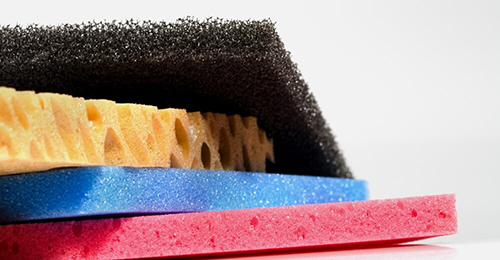PUR foams

PUR foams are among the materials with the widest variety of application and solution options - and have been our core business for more than 50 years.
Due to their open cell structure and elastic cell webs, PUR foams are very flexible and have a high resilience depending on the type. In addition, the open cell structure ensures high air permeability and fluid absorption.
Because of these properties, polyurethane foams are used not only as mattresses, but also as upholstery materials in the furniture and automotive industries. In the packaging sector, they play an important role due to their shock-absorbing properties and high flexibility. In industry and technology they are used as seals as well as for vibration and sound damping. And in the consumer sector, they are indispensable as materials for cleaning and care sponges.
Polyurethanes are among the reaction plastics. As a rule, a PUR reaction system consists of two raw material components and additives, such as color pigments, fillers and foaming agents. The raw material components are polyols and isocyanates. When mixed with the propellant, they react to PUR. In this case, the blowing agent forms gas inclusions, which lead to the cells or pores in the foam. PUR foams exist in different degrees of hardness depending on the application, from soft to semi-hard to hard.
PUR foams are open-cell foams. This means that in the last phase of the foaming process, the cell walls burst open. Basically, one differentiates depending on the polyols used between polyester and polyether foams, which differ by their respective technical properties. In addition, PU foams differ mainly in their density, their compressive strength and their cell structure.
The density refers to the density of a foam and is generally expressed in kilograms per cubic meter. The compressive strength indicates how "firm" a foam is, ie how much force is necessary to compress it. It is usually given in kilopascals. Finally, the cell structure influences the mechanical properties of the foam and is specifically controlled during the foaming process. In the case of filter foams, for example, a very regular and open cell structure is usually sought, the cell size varying according to the intended use. In sponge foams, however, the irregular cell structure of a natural sponge is modeled to ensure the highest possible fluid absorption.
The macro shots on this page are intended to give you an idea of the characteristics of the different foams. In order to clarify the different cell sizes and structures, the same image section was always selected. Of course, in addition to the types shown, many more are available.